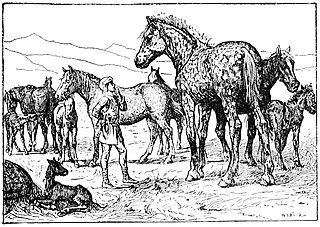
TamLin is a character in a legendary ballad originating from the Scottish Borders. It is also associated with a reel of the same name, also known as the Glasgow Reel. The story revolves around the rescue of Tam Lin by his true love from the Queen of the Fairies. The motif of winning a person by holding him through all forms of transformation is found throughout Europe in folktales.

"The Sorcerer's Apprentice" is a poem by Johann Wolfgang von Goethe written in 1797. The poem is a ballad in 14 stanzas.

Joseph Jacobs was an Australian folklorist, translator, literary critic, social scientist, historian and writer of English literature who became a notable collector and publisher of English folklore.

"The Master Maid" is a Norwegian fairy tale collected by Peter Christen Asbjørnsen and Jørgen Moe in their Norske Folkeeventyr. "Master" indicates "superior, skilled." Jørgen Moe wrote the tale down from the storyteller Anne Godlid in Seljord on a short visit in the autumn of 1842. Andrew Lang translated the tale to English and included it in his The Blue Fairy Book (1889). A later translation was made by George Dasent, in his Popular Tales from the North.
"Cap-o'-Rushes" is an English fairy tale published by Joseph Jacobs in English Fairy Tales.
Catskin is an English fairy tale collected by Joseph Jacobs, in More English Fairy Tales. Marian Roalfe Cox, in her pioneering study of Cinderella, identified as one of the basic types, the Unnatural Father, contrasting with Cinderella itself and Cap O' Rushes.

"The Master Thief" is a Norwegian fairy tale collected by Peter Chr. Asbjørnsen and Jørgen Moe. The Brothers Grimm included a shorter variant as tale 192 in their fairy tales. Andrew Lang included it in The Red Fairy Book. George Webbe Dasent included a translation of the tale in Popular Tales From the Norse. It is Aarne–Thompson type 1525A, Tasks for a Thief.
"The Thief and His Master" is a German fairy tale collected by the Brothers Grimm in Grimm's Fairy Tales as tale number 68. In the first edition there was another fairy tale at place 68. The name of the fairy tale is "Von dem Sommer- und Wintergarten".

Dapplegrim (Grimsborken) is a Norwegian fairy tale collected by Peter Christen Asbjørnsen and Jørgen Moe in their Norske Folkeeventyr. Andrew Lang included it in The Red Fairy Book.
The Red Ettin or The Red Etin is a fairy tale collected by Joseph Jacobs. It was included by Andrew Lang in The Blue Fairy Book.

"The Robber Bridegroom" is a German fairy tale collected by the Brothers Grimm, tale number 40. Joseph Jacobs included a variant, Mr Fox, in English Fairy Tales, but the original provenance is much older; Shakespeare alludes to the Mr. Fox variant in Much Ado About Nothing, Act 1, Scene 1:
"Nix Nought Nothing" is a fairy tale included in Joseph Jacobs's anthology, English Fairy Tales (1898). Nix Nought Nothing is a translation of the Scottish tale "Nicht Nought Nothing", originally collected by Andrew Lang from an old woman in Morayshire, Scotland.

The Battle of the Birds is a Scottish fairy tale collected by John Francis Campbell in his Popular Tales of the West Highlands. He recorded it in 1859 from a fisherman near Inverary, John Mackenzie and was, at the time, building dykes on the Ardkinglas estate. Joseph Jacobs took it from there for his Celtic Fairy Tales and added some additional elements.

"The Brave Little Tailor" or "The Valiant Little Tailor" or "The Gallant Tailor" is a German fairy tale collected by the Brothers Grimm. "The Brave Little Tailor" is a story of Aarne–Thompson Type 1640, with individual episodes classified in other story types.

"The Water of Life" is a German fairy tale collected by the Brothers Grimm, tale number 97.

The King of England and his Three Sons is a Romani fairy tale collected by Joseph Jacobs in More English Fairy Tales. He listed as his source Francis Hindes Groome's In Gypsy Tents, where the informant was John Roberts, a Welsh Roma. Groome published the tale as An Old King and his three Sons in England.
The Tale of the Shifty Lad, the Widow's Son is a Scottish fairy tale collected by John Francis Campbell in Popular Tales of the West Highlands. Andrew Lang included it, as The Shifty Lad in The Lilac Fairy Book. The tale was reprinted in Scottish Fairy and Folk Tales, by George Brisbane Scott Douglas.

"Puss in Boots" is an Italian fairy tale, later spread throughout the rest of Europe, about an anthropomorphic cat who uses trickery and deceit to gain power, wealth, and the hand of a princess in marriage for his penniless and low-born master.

"Kobutori Jiisan" translated directly as "Lump-Taken Old Man" is a Japanese Folktale about an old man who had his lump taken or removed by demons after joining a party of demons (oni) celebrating and dancing in the night.
Lady Featherflight is an American fairy tale first published in 1891, by W. W. Newell and collected from an oral source in Cambridge, Massachusetts. In the tale, a traveler is offered hospitality by Lady Featherflight, a giant's daughter. He is forced to perform a number of tasks for her father, but Featherflight offers him assistance through her control over birds. They eventually elope and steal her father's treasure.












